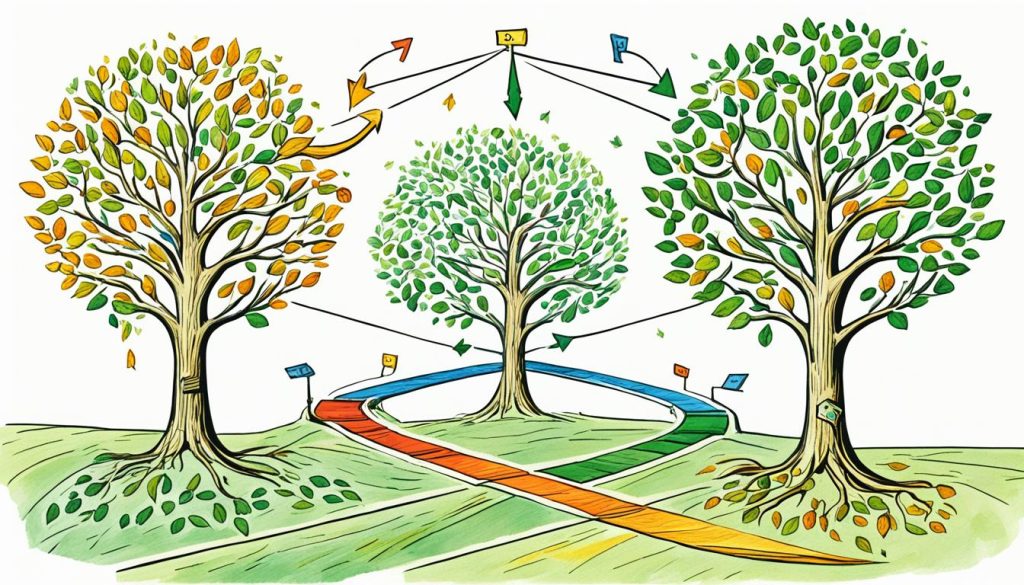As an investor, you’re always looking for ways to make your money work better and avoid risks. But, many don’t know about the hidden risks in the1 Binomial Option Pricing Model. This model is key in the finance world2 for figuring out the right price for financial options. It’s important to get it to make smart investment choices.
The Binomial Option Pricing Model was created in the 1970s by Cox, Ross, and Rubinstein1. It says the price of an asset can go up or down in small steps1. The model uses a binomial tree to show these price changes. It then figures out the right price for financial options1. Important things like the stock price, strike price, and how much risk you’re taking on matter in this model1.
The model is based on the idea that investors don’t care about risk when making choices2. This idea helps decide the chances of different outcomes in the binomial tree1. By using these chances, the model finds the right price for an option by going back through the tree1.
Learning about the Binomial Option Pricing Model can help you make better investment choices. It lets you see the risks you might not know about in your financial plans. By understanding this model, you can make smarter choices to protect your money.
Key Takeaways
- The Binomial Option Pricing Model is a way to find the fair value of financial options.
- This model thinks the asset’s price can only go up or down in small steps, making a binomial tree of prices.
- Risk-neutral probability is key in the Binomial Model, meaning investors don’t care about risk when making choices.
- The model uses these probabilities to figure out the chances of different outcomes, helping find the right price for an option.
- Knowing the Binomial Option Pricing Model can help investors spot hidden risks and make better investment decisions.
- https://balamga.com/discover-the-hidden-gems-of-how-to-book-last-minute-flights/
Binomial Option Pricing Model: An Overview
The binomial option pricing model is a key method for valuing options. It was created by Cox, Ross, and Rubinstein in 197934. This model assumes the asset’s price moves in two ways (up or down) at each time step. It uses a binomial tree to show possible price paths3.
The model is based on risk-neutral probability. It calculates the theoretical option price. This includes the asset’s current price, strike price, time left, volatility, and risk-free interest rate3.
What is the Binomial Option Pricing Model?
This model is great for valuing many option types, like European and American options, and some exotic options3. It’s popular because it assumes no arbitrage, making it easy to use for traders and investors3. The model’s multi-period view, simplicity, and accuracy in valuing American-style options are big pluses3.
Assumptions and Applications of the Model
The main idea behind the binomial model is that stock prices can only go up or down in each step34. To value options, a binomial tree is built, and values are calculated for each period3. This model helps traders understand option values by looking at stock price movements3.
While great for American-style options, the binomial model might not work well for complex options like real options or Asian options. For these, Monte Carlo models are often used4.
The binomial option pricing model is a strong tool for valuing options. It gives a discrete-time look at the continuous process of the Black–Scholes model4. Its flexibility and simplicity make it a top choice for option traders and investors wanting to grasp and manage risks in their financial plans.
Key Concepts and Terminology
The binomial option pricing model is a powerful tool for valuing options. It uses a binomial tree to show how the price of an asset might move5. Each node on the tree shows a possible price at a certain time. The model looks at two possible price changes: up or down5.
This method is better than the Black-Scholes model because it can handle changing volatility and small price changes5.
Binomial Tree and Nodes
The binomial option pricing model relies on a binomial tree to show possible price paths of an asset6. Each node on the tree is a possible price at a certain time. The model says the price can only go up or down by a set amount in each time period6.
The more time steps in the model, the more detailed it can be about the asset’s price changes6.
Risk-Neutral Probability and Option Premium
The model uses a risk-neutral probability to figure out the option’s value5. This probability makes the option’s value equal to the expected risk-free return. The model calculates the option’s value at each node, considering its intrinsic value and expected future value5.
The option premium is the price to buy the option. It reflects the fair value based on the asset’s price, volatility, and other factors5.
Getting the model’s parameters right is key for a fair option value6. The model can be adjusted for different types of options, including American-style options that can be exercised early6.
“The binomial model is more intuitive and practical than the Black-Scholes model in terms of understanding and application.”5
The binomial model has its perks but also has some downsides. It can be more work to calculate, especially for options with a long time until they expire5. It also assumes constant interest rates and volatility, which might not always be true in the market5.
Many financial experts use both the Black-Scholes and binomial models. They start with the Black-Scholes model and then use the binomial model for more complex cases5.
binomial option pricing model: Underlying Mechanisms
The Binomial Option Pricing Model (BOPM) helps estimate option values by simulating price movements of the underlying asset7. It builds a binomial tree where the asset’s price can go up or down by a set factor at each step8.
Constructing the Binomial Tree
First, the BOPM builds the binomial tree. It finds the up and down factors based on the asset’s volatility and time interval8. The model assumes constant volatility, making it efficient for pricing options by dividing time into steps8.
Calculating Option Values at Each Node
The BOPM calculates the option’s value at each binomial tree node, working backward from the end to the start7. This method finds the option’s present value, which is the theoretical price7. The model’s risk-neutral valuation makes sure the option’s price is fair and follows the no-arbitrage principle7.

“The Binomial Model divides time into discrete intervals for pricing options efficiently, and implies there are only two possible outcomes for the underlying asset’s price – it can go up or down by a specified factor during each interval.”
The BOPM is a great tool for valuing options but has limits. It assumes constant volatility and no dividends, which might not match real markets8. Also, making the binomial tree can be hard, especially for options with many time steps. Small changes in inputs can greatly affect option prices8.
Overall, the Binomial Option Pricing Model offers a clear and flexible way to value options, especially American-style options that can be exercised early7. By grasping the BOPM’s mechanics, investors and financial experts can make better choices with their options-based strategies7.
Types and Variations of Binomial Option Pricing Models
The original Binomial Option Pricing Model was for European-style options. But, there are many variations for different options. The Cox-Ross-Rubinstein (CRR) model is a classic9. The Jarrow-Rudd model makes the risk-neutral probabilities more like continuous-time models like Black-Scholes9. These models can value American-style options and exotic options, like barrier options and binary options10.
The Black-Scholes model from 1973 is for pricing European options on stocks. It assumes certain things, like normally distributed returns and constant volatility9. The model uses the asset’s price, strike price, volatility, and other factors9.
The Binomial Option Pricing Model is for pricing American options. It models the price changes over time10. This model uses a binomial tree to show how the option’s price changes10.
These models help finance experts find the theoretical values of options. This helps in making better trading decisions9. Knowing about these models and their strengths is crucial for smart investment choices11.

| Model | Type of Options | Key Factors |
|---|---|---|
| Cox-Ross-Rubinstein (CRR) | European | Risk-neutral probability, Binomial tree |
| Jarrow-Rudd | European | Risk-neutral probability, Alignment with Black-Scholes |
| Binomial Option Pricing Model | American | Iterative solution, Binomial tree, Factors u and d |
| Black-Scholes | European | Underlying asset price, Strike price, Volatility, Time, Interest rate, Dividend yield |
Option pricing models have evolved to suit different options and markets. From the Cox-Ross-Rubinstein and Jarrow-Rudd models for European options to the Binomial Option Pricing Model for American options, finance experts have many tools. These help them understand the options market91011.
Conclusion
The binomial option pricing model is a key tool for understanding options and financial derivatives. It breaks down time to expiration into steps and models the price movements of the asset. This makes it a flexible way to estimate option values12.
Even though it’s not as precise as the Black-Scholes model, the binomial model has big advantages. It’s easy to calculate, shows option values over time, and works well for American options12. It assumes a constant risk-free rate and no transaction costs. These assumptions help you understand options better and make smarter financial choices12.
When you’re into options and derivatives, the binomial model is a great tool for managing risk. By grasping concepts like the binomial tree and risk-neutral probabilities, you can better understand options. This knowledge lets you make smarter investment plans1314. It’s useful for finance pros and individual investors alike, helping you move through the financial world with confidence and success.
FAQ
What is the Binomial Option Pricing Model?
The Binomial Option Pricing Model is a way to figure out the fair value of financial options. It says the price of an asset can only go up or down in small steps. This creates a binomial tree showing all possible price changes.
What are the key assumptions of the Binomial Option Pricing Model?
This model assumes the asset price moves in two ways (up or down) at each small time step. It uses a binomial tree to show these price changes. It also uses risk-neutral probability to find the option’s theoretical price. This takes into account the asset’s current price, strike price, time left, volatility, and risk-free interest rate.
How does the Binomial Option Pricing Model work?
The model builds a binomial tree by figuring out the up and down price movements at each step. It uses risk-neutral probability to find the option’s value at each point. Working backwards from the end, it finds the option’s present value. This is the theoretical price of the option.
What are the different types and variations of the Binomial Option Pricing Model?
The original model was for European-style options. But, there are many variations for different options. The Cox-Ross-Rubinstein (CRR) model is a classic version. The Jarrow-Rudd model tweaks the risk-neutral probabilities. These models can value American-style options and exotic options like barrier and binary options.
How can the Binomial Option Pricing Model help investors manage financial risks?
This model is a powerful tool for investors. It helps them understand and manage risks in options and derivatives. By modeling price movements and including factors like volatility and interest rates, it offers a flexible way to estimate option prices. This can help investors spot hidden risks and make better investment choices.

